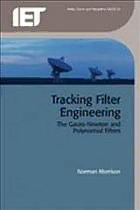
Tracking filter engineering : the Gauss-Newton and polynominal filters PDF
Preview Tracking filter engineering : the Gauss-Newton and polynominal filters
Tracking Filter Engineering The Gauss–Newton and Polynomial Filters Norman Morrison TheInstitutionofEngineeringandTechnology PublishedbyTheInstitutionofEngineeringandTechnology,London,UnitedKingdom TheInstitutionofEngineeringandTechnologyisregisteredasaCharityinEngland& Wales(no.211014)andScotland(no.SC038698). ©2013TheInstitutionofEngineeringandTechnology Firstpublished2013 ThispublicationiscopyrightundertheBerneConventionandtheUniversalCopyright Convention.Allrightsreserved.Apartfromanyfairdealingforthepurposesofresearchor privatestudy,orcriticismorreview,aspermittedundertheCopyright,DesignsandPatentsAct 1988,thispublicationmaybereproduced,storedortransmitted,inanyformorbyanymeans, onlywiththepriorpermissioninwritingofthepublishers,orinthecaseofreprographic reproductioninaccordancewiththetermsoflicencesissuedbytheCopyrightLicensing Agency.Enquiriesconcerningreproductionoutsidethosetermsshouldbesenttothe publisherattheundermentionedaddress: TheInstitutionofEngineeringandTechnology MichaelFaradayHouse SixHillsWay,Stevenage Herts,SG12AY,UnitedKingdom www.theiet.org Whiletheauthorandpublisherbelievethattheinformationandguidancegivenin thisworkarecorrect,allpartiesmustrelyupontheirownskillandjudgementwhen makinguseofthem.Neithertheauthornorpublisherassumesanyliabilityto anyoneforanylossordamagecausedbyanyerrororomissioninthework,whether suchanerrororomissionistheresultofnegligenceoranyothercause.Anyandall suchliabilityisdisclaimed. Themoralrightsoftheauthortobeidentifiedasauthorofthisworkhavebeen assertedbyhiminaccordancewiththeCopyright,DesignsandPatentsAct1988. BritishLibraryCataloguinginPublicationData AcataloguerecordforthisproductisavailablefromtheBritishLibrary ISBN978-1-84919-554-6(hardback) ISBN978-1-84919-555-3(PDF) TypesetinIndiabyMPSLimited PrintedintheUKbyCPIAntonyRowe,Chippenham,Wiltshire Why this book? FormanyyearstheKalmanfilterhasbeentheacceptedapproachtotrackingfilter engineering. Thepurposeofthisbookistopresentanalternateapproach,onebasedontheGauss– Newtonfilterswhichwebelieveoffercertainimportantadvantages.Wealsoprovide afulldiscussionofthepolynomialfilters. ◊ InChapters1to7wecoverthenecessarybackground. ◊ InChapters8and9wediscussthedetailsoftheGauss–Newtonfilters. ◊ Chapter10isdevotedtotheMasterControlAlgorithms(MCAs)thatareusedto controltheGauss–Newtonfilterswhenmanoeuvringtargetsarebeingtracked. ◊ InChapter11weprovideabriefdiscussionontheKalmanandSwerlingfilters. ◊ Chapters12and13aredevotedtothepolynomialfilters. Welcome, then, to tracking filter engineering based on the Gauss–Newton and polynomialfilters. Organisation As shown below, the material comes in two parts – the printed part and the supplementarymaterial. Printedpart Supplementarymaterial Preface Computerprograms Contents Miscellaneous Chapters1to13 Problemsandsolutions andtheirappendices Projects References Videoclips Index Theprintedpartisthebookthatyouarenowreading.Itiscompletelyself-contained andispublishedbytheInstitutionofEngineeringandTechnology(IET). Thesupplementarymaterialisforthosereaderswhowishtoexplorethesubjectin greaterdepth. PleasenotethattheIETisnotresponsibleforanyofthesupplementarymaterial,and thattheauthorhasthesoleresponsibilityforitscreationandmaintenance. ThesupplementarymaterialishousedintheUniversityofCapeTown’sOpenAccess Databaseandcanberetrievedfromthefollowing(case-sensitive)URL: http://bit.ly/MorrisonSSP Thematerialcanalsoberetrievedfromthefollowing(alsocase-sensitive)URL: http://goo.gl/DD82m Kindlysendtheauthoranemailatthefollowingaddress [email protected] Organisation 3 sothathecannotifyyouwhenanewreleaseofthesupplementarymaterialbecomes available. Please include the words Tracking Filter Engineering in the title of youremail. (cid:1)(cid:2) Thesupplementarymaterialconsistsofthefollowing: ◊ Computerprograms:Fourteencomputerprograms,allofwhicheitherverifyor demonstratesomethingimportantthatisdiscussedinthebook.Includedareboth theexecutablesandthesourcecodelistings.Documentationforrunningeachof the programs has been included in the form of a short Quickstart and also, in manycases,amoredetailedReadme. ◊ Miscellaneous:Containsanumberoffiles,executablesanddocumentsthatare referredtoasneeded. ◊ Problemsandsolutions:Containssetsofproblemsforeachofthe13chapters. These enable you to test your understanding of the concepts discussed there, and some of the problems also include further theoretical material. Complete solutionstotheproblemshavebeenincluded. ◊ Projects:Containsprojectsformostofthe13chapters. Someoftheseinvolve writing short computer programs and others involve reading the material that hasbeenprovided.Allofthemareintendedtodeepenyourunderstandingofthe materialcontainedintheprintedchapters. ◊ Video clips: Contains two sets of video clips, one set with, and the other set withoutMCAcontrol.(ThelatterisdiscussedinChapter10.)ThesetwithMCA controlshowstheoutputofaGauss–Newtonfilterthatisbeingusedtotracka varietyofmanoeuvringtargetssuchasfixed-wingaircraft,helicoptersandcruise missiles. Intheprefacewesuggestedthatyouviewthetrack-while-scanvideo clips(thesearetheoneswithMCAcontrol)beforedoinganyfurtherreading.If youmissedthat,thenperhapsnowwouldbeagoodtimetodoso. However, first please read the document Video_Clips\TWS\Documents\ Readme.pdf so that you understand fully what you will be viewing.Then run thevideoclipsinthefolderVideo_Clips\TWS\Flights. Preface Why would anyone write a book about Gauss–Newton tracking filters? There are manyreasons.Herearejustafew. ◊ TheKalmanfilterhasbecomeanextremelycomplextopicwithabewildering numberofmutations.Bycontrast,Gauss–Newtonfiltersareeasytounderstand and easy to implement. What we are offering here is a simpler, more practi- calapproachtotrackingfilterengineeringthatwillappealtobothexperienced practitionersandtonewcomers. ◊ The Gauss–Newton filters work, and they work extremely well. We and our colleagues have established that – by using them in a variety of operational hardwareaswellasinsimulations. ◊ Once launched, Kalman filters1 have only one type of memory – expanding – somethingthatisimpossibletochange. Bycontrast,theGauss–Newtonfilterscanhavefixedlength,variablelengthor expandinglengthmemoriesandanyofthesecanbechangedatwillduringfilter operation. TheGauss–Newtonfiltermodelscanalsobechangedduringfilteroperation– ifneedbefromonecycletothenext. Thisabilitytochangetheirmemorylengthsandfiltermodelsopensuppower- fulnewwaysbywhichtotrackmanoeuvringtargets, waysthataredifficultto implementwiththeKalmanfilters. ◊ The Gauss–Newton filters can be used when the observations are stage-wise correlated,somethingthatcannotbedonewiththeKalmanfilters,andwhileit istruethatobservationsinfilterengineeringareoftenstage-wiseuncorrelated, thatisnotalwaysthecase. 1Thewords‘Kalmanfilter’meandifferentthingstodifferentpeople.Whenweusethemhereweare referringspecificallytothemainstreamversionappearinginReferences3,6,22,23,24,25,30,31,48, 50,53,54,55,56,57,173and174.TheequationsofthemainstreamversionappearinAppendix11.1. xviii Trackingfilterengineering:theGauss–Newtonandpolynomialfilters ◊ Perhapsmostimportantofall,theGauss–Newtonfiltersarenotvulnerabletothe instabilityproblemsthatplaguetheextendedKalmanfilters–inwhich,unpre- dictably, the estimation errors become inconsistent with the filter’s covariance matrix. The Gauss–Newton filters therefore do not require what is known in Kalman parlanceas‘tuning’–searchingforandincludingaQmatrixthatonehopeswill preventsomethingthatisbothunpredictableandalmostinexplicable,andinthe processdegradingtheaccuracyoftheKalmanestimate. ThisinturnmeansthatinpracticetheGauss–Newtonfiltersaremoreaccurate, andthattheyareeasiertoimplement,requireshorterprojecttime,areextremely robustand,bestofall,unconditionallystable. Andwhatcanonesayaboutexecutiontime? Using Gauss–Newton on a 1958-era machine, the extraction of a satellite’s orbital parameters from a set of radar observations would have added about one hour of processingtimeaftertheobservationshadbeenobtained. However, on today’s readily available desk-top or lap-top machines, that hour has shrunktoafewhundredmilliseconds,andascomputerperformanceandothertech- nologiessuchasFPGAcontinuetoadvance,itissafetosaythatinthenottoodistant futureitwillhaveshrunktotensofmillisecondsorevenless. (cid:1)(cid:2) As envisaged here, tracking filters are computer programs that extract estimates of the states of dynamic processes in near real-time from sequences of discrete real observations. Trackingfilterengineeringisthecollectionoftechniques,knowledgeandactivities thatweemploywhenwecreateandoperatesuchfilters. Thefollowingisapartiallistoffieldsinwhichtrackingfiltersareused: Air-traffic control, artificial intelligence, astronomy, atmospheric re-entry, ballistic missile defence, chemical engineering, civil engineering, control engineering,econometrics,electricalengineering,GPSandWAAS,industrial engineering,inertialnavigation,mechanicalengineering,missileengineering, neural networks, physics, pilotless-aircraft engineering, radar and tracking, robotics,satelliteengineering,spacenavigation,statistics,telecommunications, telescopeengineeringandwind-powerengineering. Preface xix Thisbookwillbeofinteresttothreegroupsofpeople: ◊ Practitionersworkingintheaforementionedorsimilarfields. ◊ Graduate-levelnewcomerswishingtolearnaboutGauss–Newtonandpolynomial filters,andhowtheycanbeusedinfilterengineering. ◊ UniversitylecturerswhomightwishtoincludematerialonGauss–Newtonand polynomialfiltersingraduate-levelcoursesontrackingfilterengineering. (cid:1)(cid:2) Tracking filter engineering came into existence around 1958 at the start of the SatelliteEra.2 Engineersandscientistshadlongbeenfittingcurvestodatabyleastsquares,butthis wasdifferent.Nowtherewerehugetrackingradarsmakingobservationsonartificial satellites,fromwhichestimatesoforbitalparameters–knownasKeplerians–were tobeextracted,andthefilteringalgorithmsfordoingsowerefarmoresophisticated thansimpleleastsquares. Astronomers had been estimating Keplerians of objects in orbit since the time of Gauss, usingwhatwasknownastheGauss–Newtonalgorithm. However, suchcal- culationsweredonebyhandandittookmanymonthstoobtainresults,whereaswith artificial satellites the need was for the observations to be processed by computers andfortheestimatestobeavailableinnearreal-time. RunningGauss–Newtonona1958-eramachinewouldhavetakenroughlyanhour to extract a satellite’s Keplerians from a set of radar observations after the latter hadbeenobtained.Suchadelaywasclearlytoofarremovedfromreal-time,andso Gauss–Newtoncouldnotbeused. Initsplacetwonewfiltersweredevised–bothrelatedtoGauss–Newtonbutcom- putationallydifferent.ThefirstofthesewaspublishedbySwerlingin19583andthe secondbyKalman4andBucy5in1960/61,bothofwhichcouldextractKepleriansin nearreal-timeontheexistingmachines.6 Starting from the extraction of Keplerians, use of the Kalman filter spread rapidly tothemanyotherfieldslistedabovewheretodayitoccupiesthedominantplacein 2Sputnik-1wasplacedinorbitbytheSovietUniononOctober4th,1957.SeeReference40. 3PeterSwerling(Americanmathematicianandradartheoretician), 1929–2000. SeeReferences7, 8, 9,91. 4RudolfEmilKalman(Hungarian-bornAmericanscientist),b.1930.SeeReferences1,2,92. 5RichardS.Bucy(Americanmathematician),b.1935.SeeReference93. 6SeeChapter11forwhatwemeanby‘Swerlingfilter’and‘Kalmanfilter’. xx Trackingfilterengineering:theGauss–Newtonandpolynomialfilters filterengineering.TheKalmanfilterhasalsocometooccupythedominantplacein filter-engineeringcurriculathroughouttheacademicworld. (cid:1)(cid:2) Butwhileallofthiswastakingplace,somethingelsewasalsohappening. Since1958,computertechnologyhasmadeadvancesthataredifficulttocomprehend, and the end is still nowhere in sight. Consider for example the following item that appearedontheIntelcorporatewebsite: ‘Intel remains at the forefront of Moore’s Law. Our 22 nanometer technology- basedIntelmicroprocessorswillenablenever-before-seenlevelsofperformance, capability,andenergy-efficiencyinarangeofcomputingdevices.’ Andso,whileitmayhavebeenappropriatetorejectGauss–Newtonin1958,itisno longerappropriatetodosotoday.Inthisbookweaccordinglydosomethingdifferent. Many books have been written about the Kalman filter – the author is aware of at least fifteen. However, to our knowledge nobody has yet written a book about the Gauss–Newton filters and their remarkable fit to certain important areas of filter engineering. This then is our attempt to do so, and to present those filters in a readable and self-containedway. (cid:1)(cid:2) TheGauss–Newtonfilterspossessattributesthatmakethemparticularlywell-suited foruseintrackingfilterengineering,amongthemthefollowing: ◊ Idealfortrackingbothmanoeuvringandnon-manoeuvringtargets. ◊ Canbeusedwhentheobservationsarestage-wisecorrelated. ◊ ArenotvulnerabletotheinstabilityphenomenathatplagueboththeKalmanand Swerlingextendedfilters,andhencerequirenotuning. ◊ Requirenoinitializationintheall-linearcaseandverylittleinthethreenonlinear cases. ◊ Possesstotalflexibilitywithregardto ◊ Memories that can be configured as fixed length, variable length or expandinglength–andifneedbe,reconfiguredcyclebycycle. ◊ Filtermodelsthatcanalsobereconfigured,ifneedbe,fromcyclebycycle. Preface xxi ◊ Offerimmediateaccesstotheresidualswhichcanthenbeusedtorungoodness- of-fittests.7 ◊ Unconditionally stable, meaning that they are always error/covariance-matrix consistent.8 ◊ Cramér–Rao consistent, meaning that their accuracy is the best that it can possiblybe. ◊ Canemploynonlinearmodelsofalmostanycomplexity. ◊ Nonrecursive,andhencedevoidofinternaldynamics. ◊ Easytoimplement. ◊ Extremelyrobust. Thetechniquesproposedinthisbookhaveallbeentestedinsimulations,andmany ofthemhavebeenusedinoperationalhardwarebuiltbyindustrialorganizationswith whichtheauthorhasbeenassociated. Theengineerswhocreatedthefiltersforthoseapplicationshavemadeitknownhow easyitwastodothat,andhowrobustweretheresultingfilters. (cid:1)(cid:2) RegardingGauss–Newtonexecutiontimeontoday’smachines: Wehavecarriedoutsimulator-basedtimingstudiesinwhichtheGauss–Newtonfilters were used to track a mix of manoeuvring targets such as high-performance mili- tary jets, cruise missiles and helicopters. We found that readily available modern computers–eitherdesktoporlaptop–canreadilyhandletheloadimposedbythese filterswhiletrackingmanysuchtargets, includingalloftheoverheadcalculations, namelytrackformation,trackdeletionandplot-to-trackallocationusingtheauction algorithm. Indeed,dependingonthelevelofradarclutter,ourstudieshavesuggestedthatcon- currenttrackingofamixofpossiblyasmanyasfiftymanoeuvringtargetsofthiskind canbeaccomplishedonsuchcomputersusingthesefilters,andasprocessingpower continuestoincrease,theconservativefigureoffiftywillcontinuetorise. 7Goodness-of-fittestsareusedbytheMasterControlAlgorithms(MCAs)tocontrolaGaussfilter’s memorylengthandfiltermodelwhentrackingmanoeuvringtargets,insuchawaythatitsperformanceis alwaysoptimal.TheMCAsarediscussedinChapter10. 8Error/covariance-matrix(ECM)consistencyisdiscussedinChapter1.WhenaKalmanorSwerlingfilter becomesunstablethenitisECMconsistencythatisabsent,aconditionwhichisfatal.
